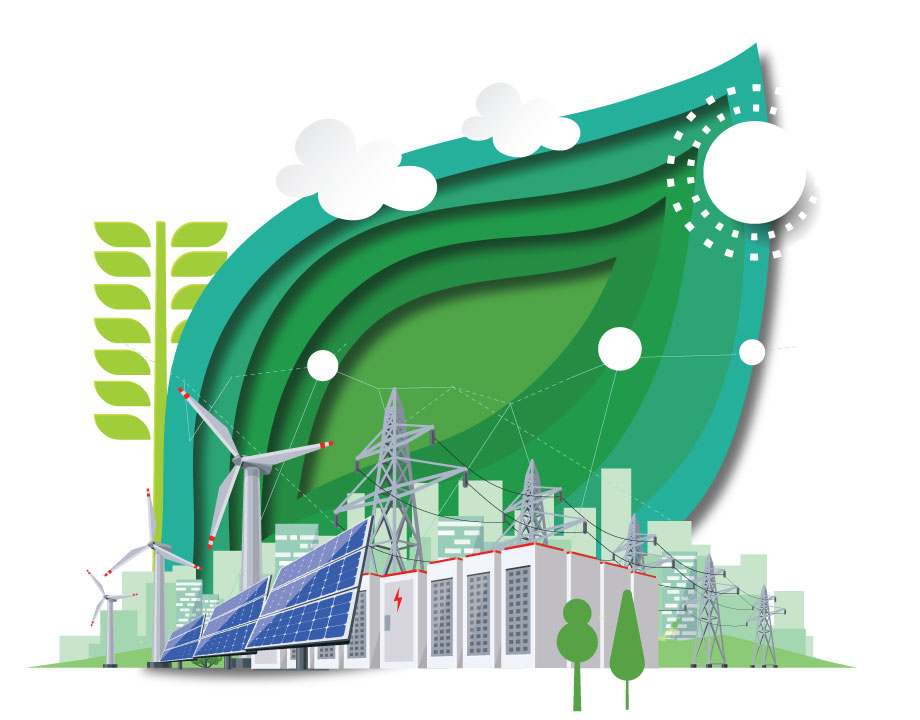Energy Blog: Gas Power Plants Are Efficiency Giants
Energy Blog: Gas Power Plants Are Efficiency Giants


A recent report shows how the combined-cycle gas turbine fleet is increasingly efficient and reliable.
Gas turbines used in power plants are in many ways similar to jet engines. A large compressor brings in air to mix with fuel; when that fuel-air mix is ignited, the expanding hot gases drive a turbine that turns both the compressor and—in the case of a power plant—an electric generator. In some power plants, the hot exhaust is harnessed again to make steam that powers a second turbine and generator.
That combined-cycle sounds needlessly complicated, but the added steam cycle turbine wrings more work from one unit of fuel than a single gas turbine can. Gas turbine expert Lee S. Langston has been charting the progress of gas turbine efficiency in the pages of Mechanical Engineering magazine for more than two decades, and he once calculated that the maximum theoretical efficiency for a combined-cycle gas turbine: Get the gas turbine to run at 50 percent efficiency and the steam turbine to run at 40 percent efficiency, and the combined-cycle plant would be 70 percent efficient.
 The current champions at efficiency are very large combined-cycle gas turbine (CCGT) plants, which reach up to 64 percent efficiency. But these huge machines, which can generate more than 800 MW, are uncommon. Of the several factors that made gas turbines a popular choice for utilities over the past 20 years, one of the most important is the flexibility in sizing. Smaller turbines that met the immediate needs of utilities were prized over larger units. And until recently, utilities often purchased single-cycle gas turbines for peak generation to supplement large, baseload power plants (usually coal or nuclear) in times of high demand.
The current champions at efficiency are very large combined-cycle gas turbine (CCGT) plants, which reach up to 64 percent efficiency. But these huge machines, which can generate more than 800 MW, are uncommon. Of the several factors that made gas turbines a popular choice for utilities over the past 20 years, one of the most important is the flexibility in sizing. Smaller turbines that met the immediate needs of utilities were prized over larger units. And until recently, utilities often purchased single-cycle gas turbines for peak generation to supplement large, baseload power plants (usually coal or nuclear) in times of high demand.
Recent data from the Energy Information Administration suggests that these tendencies are changing. Combined cycle gas turbines are being used more hours, on average, than ever before. And their operating efficiency is rising, perhaps as a consequence.
Research News: 3D-Printed Ceramic Turbine Parts Withstand High Temperatures
The report shows that for the entire fleet of combined-cycle plants, the capacity factor—the number of operating hours divided by the number of hours in a year—increased to 57 percent in 2022, compared to 40 percent in 2008. To be sure, some of that was due to the price of gas, which was lower in 2022 even before factoring in inflation. (While international events spiked gas prices last year, shale gas was just beginning to be exploited in 2008 and supplies were tight.) But the EIA also demonstrated that newer, larger, and more efficient units had higher capacity factors.
“Grid operators generally dispatch generators sequentially from lowest to highest cost,” the report stated. “Because CCGT units built between 2010 and 2022 typically have the lowest operating costs, they are dispatched more frequently compared with older CCGT power plants. In 2022, the capacity factor of CCGT units that began operations between 2010 and 2022 averaged 64 percent, compared with 55 percent for those that began operations between 2000 and 2009 and 35 percent for units that began operations between 1990 and 1999.”
In addition, those newer units ran more efficiently. Power plants generally measure their efficiency in terms of “heat rate,” the amount of fuel needed to generate 1 kWh of electricity. The combined-cycle plants placed online since 2010 operated at an average heat rate of 6,960 Btu/kWh, which works out to about 49 percent. The EIA says that’s 7 percent more efficient than older CCGT in operation.
Even simple-cycle machines are getting more use. According to EIA figures, the capacity factor for these flexible plants broke the 20 percent mark for the first time in 2022. The agency attributed this to the plants' ability to ramp up quickly to make up for shortfalls from intermittent sources such as solar and wind power.
Selected for You: Simulation Examines Hidden Gas Turbine Mixing
The adoption of gas turbines has also increased the efficiency at which water is used for power generation. Water is needed to cool the steam generated in coal and nuclear plants; a typical coal plant uses more than 19,000 gallons for every MWh of electricity generated. While CCGT need water cooling for their steam cycle, withdrawals are much smaller, only 2,800 gallons per MWh. As a consequence of shifting from coal to gas and renewables, water withdrawals in the power sector dropped to 47.7 trillion gallons in 2022, down from more than 60 trillion gallons in 2014.
The power industry is set to add more than 8 GW of gas generating capacity this year, with the majority of that coming in the form of large combined-cycle gas turbines. With those additions, the efficiency and utilization of gas turbines will likely increase further.
Jeffrey Winters is editor in chief of Mechanical Engineering magazine.
That combined-cycle sounds needlessly complicated, but the added steam cycle turbine wrings more work from one unit of fuel than a single gas turbine can. Gas turbine expert Lee S. Langston has been charting the progress of gas turbine efficiency in the pages of Mechanical Engineering magazine for more than two decades, and he once calculated that the maximum theoretical efficiency for a combined-cycle gas turbine: Get the gas turbine to run at 50 percent efficiency and the steam turbine to run at 40 percent efficiency, and the combined-cycle plant would be 70 percent efficient.

Recent data from the Energy Information Administration suggests that these tendencies are changing. Combined cycle gas turbines are being used more hours, on average, than ever before. And their operating efficiency is rising, perhaps as a consequence.
Research News: 3D-Printed Ceramic Turbine Parts Withstand High Temperatures
The report shows that for the entire fleet of combined-cycle plants, the capacity factor—the number of operating hours divided by the number of hours in a year—increased to 57 percent in 2022, compared to 40 percent in 2008. To be sure, some of that was due to the price of gas, which was lower in 2022 even before factoring in inflation. (While international events spiked gas prices last year, shale gas was just beginning to be exploited in 2008 and supplies were tight.) But the EIA also demonstrated that newer, larger, and more efficient units had higher capacity factors.
“Grid operators generally dispatch generators sequentially from lowest to highest cost,” the report stated. “Because CCGT units built between 2010 and 2022 typically have the lowest operating costs, they are dispatched more frequently compared with older CCGT power plants. In 2022, the capacity factor of CCGT units that began operations between 2010 and 2022 averaged 64 percent, compared with 55 percent for those that began operations between 2000 and 2009 and 35 percent for units that began operations between 1990 and 1999.”
In addition, those newer units ran more efficiently. Power plants generally measure their efficiency in terms of “heat rate,” the amount of fuel needed to generate 1 kWh of electricity. The combined-cycle plants placed online since 2010 operated at an average heat rate of 6,960 Btu/kWh, which works out to about 49 percent. The EIA says that’s 7 percent more efficient than older CCGT in operation.
Even simple-cycle machines are getting more use. According to EIA figures, the capacity factor for these flexible plants broke the 20 percent mark for the first time in 2022. The agency attributed this to the plants' ability to ramp up quickly to make up for shortfalls from intermittent sources such as solar and wind power.
Selected for You: Simulation Examines Hidden Gas Turbine Mixing
The adoption of gas turbines has also increased the efficiency at which water is used for power generation. Water is needed to cool the steam generated in coal and nuclear plants; a typical coal plant uses more than 19,000 gallons for every MWh of electricity generated. While CCGT need water cooling for their steam cycle, withdrawals are much smaller, only 2,800 gallons per MWh. As a consequence of shifting from coal to gas and renewables, water withdrawals in the power sector dropped to 47.7 trillion gallons in 2022, down from more than 60 trillion gallons in 2014.
The power industry is set to add more than 8 GW of gas generating capacity this year, with the majority of that coming in the form of large combined-cycle gas turbines. With those additions, the efficiency and utilization of gas turbines will likely increase further.
Jeffrey Winters is editor in chief of Mechanical Engineering magazine.

